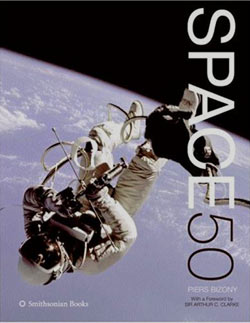Review: Space 50by Jeff Foust
|
| One theme the book attempts to address is whether the Space Age, as it entered the popular imagination nearly five decades ago, is history. |
In Space 50, Bizony provides not a detailed chronological history of space exploration but rather a review of many of the key events and topics that have shaped the field in the last half-century. He covers all the major developments, but does not dwell on them and does not rehash the details about them that will be familiar already to many readers. There are not many new insights in the book, although Bizony does digress on a number of issues in the text, from the history of women in space to the use of acronyms and technical language by NASA even in times of crisis: “NASA shares with the military an instinct that potentially terrifying situations can only be handled by keeping some sense of emotional distance.” The text is broken up throughout by a large amount of high-quality images, as one might expect from a large-format book like this, ranging from familiar images from the history of spaceflight to illustrations of spacecraft that are part of NASA’s current Vision for Space Exploration.
Although it’s not explicitly stated in the book’s title, front matter, or marketing materials, the focus of Space 50 is primarily on human rather than robotic spaceflight. There is extensive discussion of past, present, and future human spaceflight activities, including a section on commercial ventures inspired by SpaceShipOne. However, robotic space exploration is largely relegated to a short chapter in the back, where the accomplishments of various missions throughout the solar system are only briefly mentioned, and limited even then mostly to Mars missions. Given the great accomplishments of unmanned spacecraft, be they rovers on Mars or satellites serving the Earth, it seems a little odd to give them such short shrift.
One theme the book attempts to address is whether the Space Age, as it entered the popular imagination nearly five decades ago, is history. “The Space Age apparently came to an end after a little more than a single decade of excitement,” the copy on the book’s dust jacket flap notes. “But is it really over?” Bizony’s answer, at least implicitly, is yes, based on plans for government exploration and commercial exploitation of space included in the book. While the next fifty years of spaceflight may indeed be “more exciting than the last”, as the dust jacket copy later concludes, it will be a different history than the previous half-century. In any case, Space 50 makes for an interesting book, particularly for those people who do feel that the Space Age came to an end decades ago.
